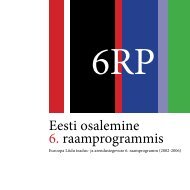Reactive Systems: Modelling, Specification and Verification - Cs.ioc.ee
Reactive Systems: Modelling, Specification and Verification - Cs.ioc.ee
Reactive Systems: Modelling, Specification and Verification - Cs.ioc.ee
Create successful ePaper yourself
Turn your PDF publications into a flip-book with our unique Google optimized e-Paper software.
4 CHAPTER 1. INTRODUCTION<br />
After having worked through the material in this book, you will be able to<br />
describe non-trivial reactive systems <strong>and</strong> their specifications using the aforementioned<br />
models, <strong>and</strong> verify the correctness of a model of a system with respect to<br />
given specifications either manually or by using automatic verification tools like<br />
the Edinburgh Concurrency Workbench (Cleavel<strong>and</strong> et al., 1993) <strong>and</strong> the model<br />
checker for real-time systems UPPAAL (Behrmann et al., 2004).<br />
Our, somewhat ambitious, aim is therefore to present a model of reactive systems<br />
that supports their design, specification <strong>and</strong> verification. Moreover, since<br />
many real-life systems are hard to analyze manually, we should like to have computer<br />
support for our verification tasks. This means that all the models <strong>and</strong> languages<br />
that we shall use in this book n<strong>ee</strong>d to have a formal syntax <strong>and</strong> semantics.<br />
(The syntax of a language consists of the rules governing the formation of statements,<br />
whereas its semantics assigns meaning to each of the syntactically correct<br />
statements in the language.) These requirements of formality are not only necessary<br />
in order to be able to build computer tools for the analysis of systems’ descriptions,<br />
but are also fundamental in agr<strong>ee</strong>ing upon what the terms in our models are<br />
actually intended to describe in the first place. Moreover, as Donald Knuth once<br />
wrote:<br />
A person does not really underst<strong>and</strong> something until after teaching<br />
it to a computer, i.e. expressing it as an algorithm.. . . An attempt to<br />
formalize things as algorithms leads to a much d<strong>ee</strong>per underst<strong>and</strong>ing<br />
than if we simply try to comprehend things in the traditional way.<br />
The pay-off of using formal models with an explicit formal semantics to describe<br />
our systems will therefore be the possibility of devising algorithms for the animation,<br />
simulation <strong>and</strong> verification of system models. These would be impossible to<br />
obtain if our models were specified only in an informal notation.<br />
Now that we know what to expect from this book, it is time to get to work.<br />
We shall begin our journey through the beautiful l<strong>and</strong> of Concurrency Theory by<br />
introducing a prototype description language for reactive systems <strong>and</strong> its semantics.<br />
However, before setting off on such an enterprise, we should describe in more<br />
detail what we actually mean with the term ‘reactive system’.<br />
1.1 What are reactive systems?<br />
The ‘st<strong>and</strong>ard’ view of computing systems is that, at a high level of abstraction,<br />
these may be considered as black boxes that take inputs <strong>and</strong> provide appropriate<br />
outputs. This view agr<strong>ee</strong>s with the description of algorithmic problems. An algorithmic<br />
problem is specified by a collection of legal inputs, <strong>and</strong>, for each legal
















